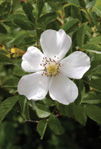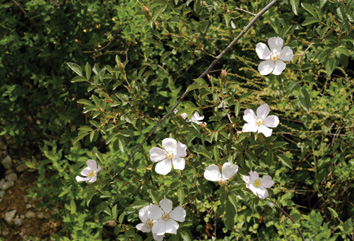

The attractive, fragrant flowers of this rose shrub, Rosa phoenicia, are produced in May. Near the Chouf Cedar Preserve on Mount Lebanon.
A ROSE BY ANY NAME IS, IN THE scriptures, not a rose. Perhaps no other plants in the Bible have been more misrepresented than entries translated “rose.” This situation is not surprising since roses were well known in Europe at the time of early Bible translations, and even used as symbols for the Royal Stuarts—England even had a War of the Roses. So it would be natural for these early scholars, removed from the flora of the Middle East, to translate an attractive plant as a rose. The best-known example is the “rose” of Sharon: “I am the rose of Sharon, the lily of the valley” (Song of Solomon 2:1, NIV). Despite uncertainty as to its proper determination, this plant is not a rose. In another verse, “I have grown tall as a palm in Ein-Gedi, as the rose bushes of Jericho” (Ecclesiasticus 24:14, NJB), the placing of the rose in Jericho is ecologically unlikely, since Jericho is an oasis in an arid region, not a place where roses are likely to be found—though they could be in a garden. Moldenke and Moldenke (1952) provide an excellent overview of some of the different ways “rose” has been translated.
Roses are in the genus Rosa and have been cultivated since ancient times. The literature on this economically important genus is vast and the history of rose introductions and breeding is extensive. There are native roses in Bible lands, attractive showy plants that certainly are well known to residents. They are all shrubs, usually well armed, technically not with thorns (which botanists consider modified branches) but with prickles (outgrowths of any plant surface), and with large, attractive flowers. These roses are usually white or light pink in the most widely distributed Levant rose, Rosa phoenicia.
Exculpating roses from the biblical text does not demean these well-known showy shrubs but does improve the accuracy of the texts.

Phoenician rose, Rosa phoenicia, widespread in the Middle East, has flowers that are light pale pink to darker hues as in this shrub near the Chouf Cedar Preserve on Mount Lebanon, in May.